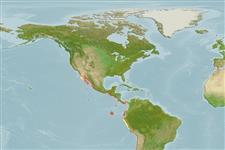Environment: milieu / climate zone / depth range / distribution range
Ekologi
laut. Tropical; 34°N - 17°S, 121°W - 71°W
Eastern Pacific: Southern California, Gulf of California and the western coast of Baja California, Mexico to Peru, including many offshore islands.
Size / Weight / umur
Maturity: Lm ? range ? - ? cm
Max length : 106 cm TL jantan/; (Ref. 55763); common length : 20.0 cm TL jantan/; (Ref. 9301)
deskripsi pendek
Kunci identifiaksi (pengenalan) | Morfologi | Morfometrik
Duri punggung (Keseluruhan (total)) : 0; duri punggung lunak (Keseluruhan (total)) : 17 - 20; Duri dubur: 0; Sirip dubur lunak: 16 - 19; vertebrata, bertulang belakang: 75 - 76. Rows of spinules in skin easily seen but individual spinules difficult to discern. Color in life orange to red above, with brownish and black blotches. Lighter below. Dorsal and anal fins with orange bases. Caudal filament dusky (Ref. 9826). Branchiostegal rays: 5 (Ref. 36710).
Adults occur at depths greater than 30 m, along continental and insular margins (Ref. 36710), over rocky substrates (Ref. 37955). Feeds on small fishes (Ref. 37955). Marketed fresh, salted or dried and smoked but more frequently processed into fishmeal (Ref. 9301).
Fritzsche, R.A. and M. Schneider, 1995. Fistulariidae. Cornetas. p. 1104-1105. In W. Fischer, F. Krupp, W. Schneider, C. Sommer, K.E. Carpenter and V. Niem (eds.) Guia FAO para Identification de Especies para lo Fines de la Pesca. Pacifico Centro-Oriental. 3 Vols. FAO, Rome. (Ref. 9301)
Status IUCN Red List (Ref. 130435)
ancaman kepada manusia
Harmless
penggunaan manusia
Perikanan: perikanan swasembada
Alat, peralatan
laporan khas
muat turun XML
Sumber internet
Estimates based on models
Preferred temperature (Ref.
123201): 20.6 - 28.4, mean 25.6 °C (based on 66 cells).
Phylogenetic diversity index (Ref.
82804): PD
50 = 0.6250 [Uniqueness, from 0.5 = low to 2.0 = high].
Bayesian length-weight: a=0.00120 (0.00062 - 0.00231), b=2.85 (2.68 - 3.02), in cm total length, based on LWR estimates for this species & (Sub)family-body (Ref.
93245).
Trophic level (Ref.
69278): 4.5 ±0.80 se; based on food items.
Daya lenting (Ref.
120179): Tinggi, Waktu penggandaan populasi minimum kurang dari 15 bulan (Preliminary K or Fecundity.).
Prior r = 0.54, 95% CL = 0.36 - 0.81, Based on 2 data-limited stock assessments.
Fishing Vulnerability (Ref.
59153): High vulnerability (64 of 100).
Nutrients (Ref.
124155): Calcium = 102 [58, 252] mg/100g; Iron = 1.61 [0.88, 2.91] mg/100g; Protein = 18.1 [16.9, 19.4] %; Omega3 = 0.197 [0.100, 0.415] g/100g; Selenium = 109 [48, 246] μg/100g; VitaminA = 9.97 [3.26, 29.30] μg/100g; Zinc = 0.838 [0.554, 1.279] mg/100g (wet weight);
